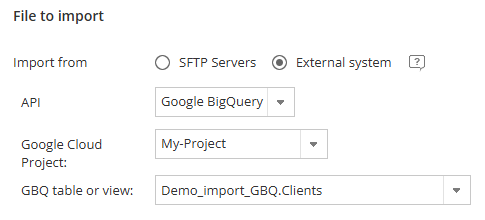The Google BigQuery integration allows you to automate the export of your Dialog Insight project to your Google Cloud project or the import of your GBQ tables toward your Dialog Insight project. This makes the transfer easier for your complementary and behavioral data generated by Dialog Insight. This way, you can easily exploit and analyze this data in your GBQ warehouse.
Access path: Project → Data Management → Integrations |
Prerequisites
- Create a Google Cloud account and a Google Cloud project
- Create a Google Cloud service account (dedicated to a connection with Dialog Insight). It is recommended to create a custom role with the following permissions :
- bigquery.datasets.create (export)
- bigquery.jobs.create (export)
- bigquery.datasets.get (import)
- bigquery.tables.list (import)
- bigquery.tables.get (import)
- bigquery.tables.getData (import)
- bigquery.readsessions.create (import)
- bigquery.readsessions.getData (import)
Step 1: Connect the GBQ Project
First, find your Google Cloud project ID:
In Dialog Insight, follow the access path and next to Google BigQuery, click Add:
Enter your Google Cloud project ID:
Upload the JSON file (exported from GBQ) that contains the account service keys:
You could then add another Google Cloud project as a source (optional) by repeating step 1:
Step 2: Configuring the Export
For the export, you can use a log export or an automated export (or both).
Be careful not to create a loop between your data sources. For example, if you configure an import from a GBQ table to a Dialog Insight project, do not configure an export from this project to the same table in GBQ.
Option 1: Log Export
Using log export will export all the tables from your project. When you export logs, a (non-editable) dataset is created in GBQ.
You must choose Google Big Query as the destination:
If you want to export all data starting from the creation of your Dialog Insight project, check Export all data on the next run*: Otherwise, you can specify the period in days to include in the next export (90 days as default).
Otherwise, you can specify the period in days to include in the next export (90 days as default).
*Remember to uncheck the option after the first export. Otherwise, every export will send the entirety of the data, which will impact the performance.
When you are done configuring a log export, remember to click Save at the bottom of the page.
Then, it is recommended to manually launch the first export so it is processed now (you must check Export all data on the next run). Click Activate:
Go to the History tab, select a task and click Launch now: → See the complete procedure for log export
→ See the complete procedure for log export
Option 2: Automated Export
It's possible to configure several automated exports (unlike a log export, there is no limit). An automated export allows the export of only one object (a table) at a time. You must configure several exports if you want to export several objects.
Select Google Big Query as the destination:
When you are done configuring an automated export, remember to click Save at the bottom of the page.
After, it's recommended to manually launch the first export so it is processed now. → See the complete procedure for automated export
→ See the complete procedure for automated export
 Select the GBQ project and the table to import (e.g. your contact or your product table). If the import involves several destinations (tables), within the same projet or not, you must configure an import for each destination. You must then map the fields, which means linking the fields from the source (GBQ) to their corresponding fields in the destination (Dialog Insight). After, it's recommended to manually launch the first import so it is processed now:
Select the GBQ project and the table to import (e.g. your contact or your product table). If the import involves several destinations (tables), within the same projet or not, you must configure an import for each destination. You must then map the fields, which means linking the fields from the source (GBQ) to their corresponding fields in the destination (Dialog Insight). After, it's recommended to manually launch the first import so it is processed now:
→ See the complete procedure for automated import
Should I create a dedicated project for Google BigQuery (for the imports)? This depends on whether you need to separate the contacts coming from this data source. In general, it is not recommended to configure more than one Dialog Insight integration within the same project, as this can lead to data conflicts, mapping issues, or unpredictable behavior during synchronization. In a CDP structure, if you want to distinguish contacts coming from different sources, it is recommended to create a dedicated source project for Google BigQuery. This project will then act as an independent source whose data can be pushed into your unified project. If you’re unsure of the best approach for your situation, feel free to contact our team for guidance tailored to your specific context. |

